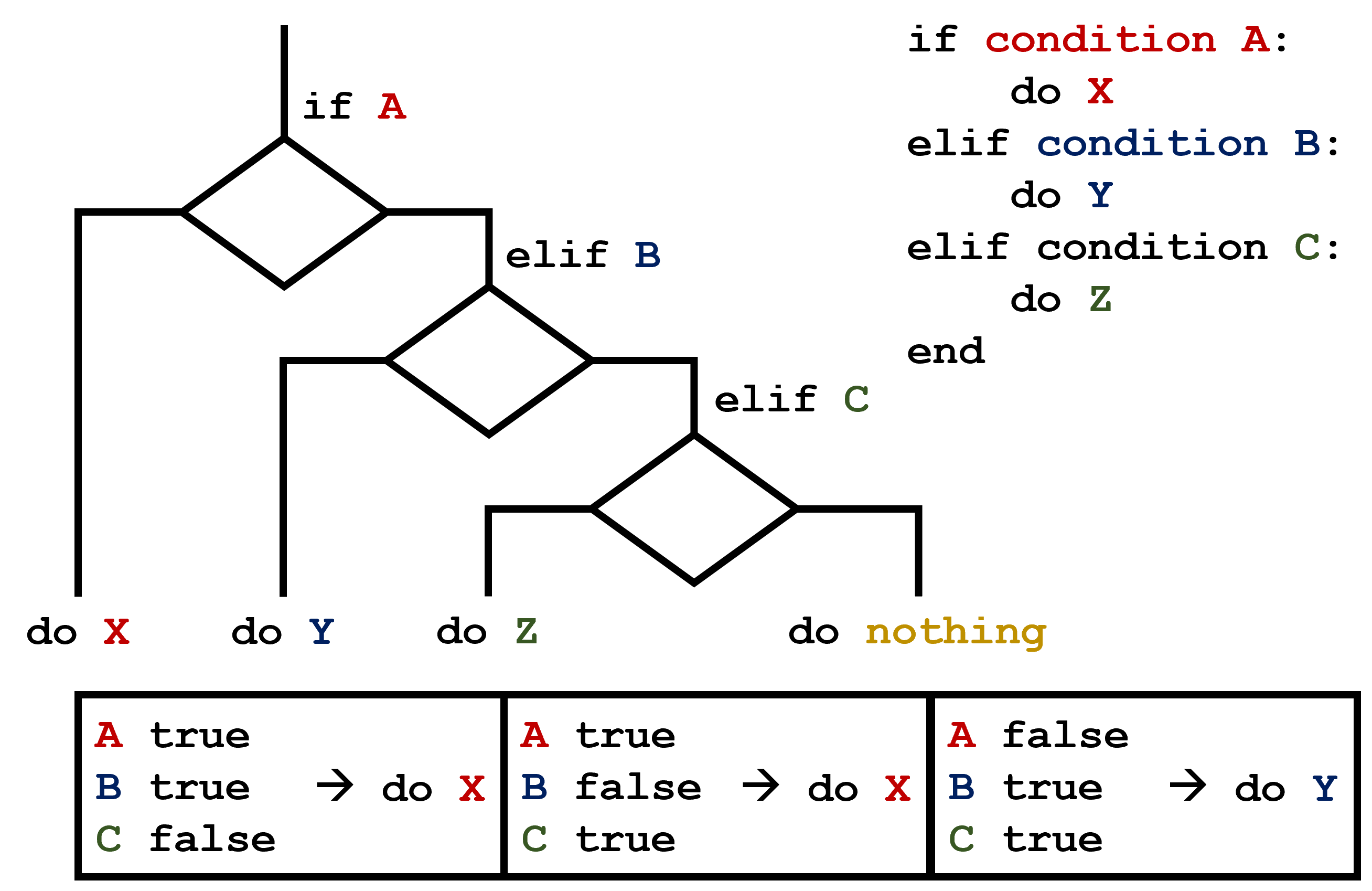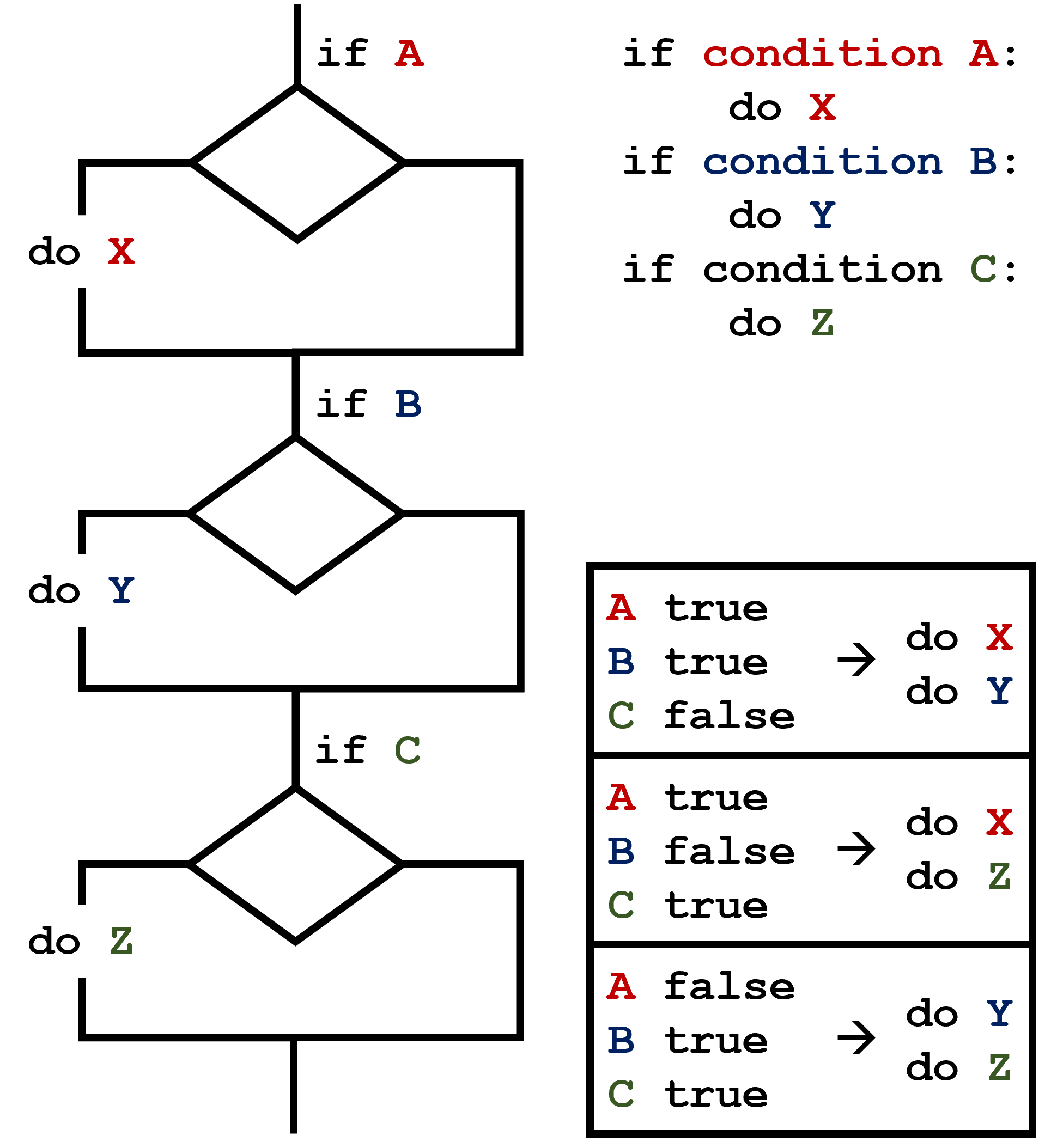Making Choices#
Objectives
Write conditional statements including
if,elif, andelsebranches.Correctly evaluate expressions containing
andandor.
Questions
How can my programs do different things based on data values?
In our last lesson, we discovered something suspicious was going on in our inflammation data by drawing some plots. How can we use Python to automatically recognize the different features we saw, and take a different action for each? In this lesson, we’ll learn how to write code that runs only when certain conditions are true.
Conditionals#
We can ask Python to take different actions, depending on a condition, with an if statement:
num = 37
if num > 100:
print('greater')
else:
print('not greater')
print('done')
not greater
done
The second line of this code uses the keyword if to tell Python that we want to make a choice.
If the test that follows the if statement is true,
the body of the if
(i.e., the set of lines indented underneath it) is executed, and “greater” is printed.
If the test is false,
the body of the else is executed instead, and “not greater” is printed.
Only one or the other is ever executed before continuing on with program execution to print “done”:

Conditional statements don’t have to include an else. If there isn’t one,
Python simply does nothing if the test is false:
num = 53
print('before conditional...')
if num > 100:
print(num, 'is greater than 100')
print('...after conditional')
before conditional...
...after conditional
We can also chain several tests together using elif,
which is short for “else if”.
The following Python code uses elif to print the sign of a number.
num = -3
if num > 0:
print(num, 'is positive')
elif num == 0:
print(num, 'is zero')
else:
print(num, 'is negative')
-3 is negative
Note that to test for equality we use a double equals sign ==
rather than a single equals sign = which is used to assign values.
Comparing in Python
Along with the > and == operators we have already used for comparing values in our
conditionals, there are a few more options to know about:
>: greater than<: less than==: equal to!=: does not equal>=: greater than or equal to<=: less than or equal to
We can also combine tests using and and or.
and is only true if both parts are true:
if 7 > 5 and 2 >= 5:
print('both parts are true')
else:
print('at least one part is false')
at least one part is false
while or is true if at least one part is true:
if 7 > 7 or 2 >= 5:
print('at least one test is true')
at least one test is true
True and False#
True and False are special words in Python called booleans, which
represent truth values. A statement such as 1 < 0 returns the value False,
while -1 < 0 returns the value True. For example:
print(1 < 0)
False
Checking our Data#
Now that we’ve seen how conditionals work,
we can use them to check for the suspicious features we saw in our inflammation data.
We are about to use functions provided by the numpy module again.
Therefore, if you’re working in a new Python session, make sure to load the
module with:
import numpy
From the first couple of plots, we saw that maximum daily inflammation has a perfectly linear rise and fall. Wouldn’t it be a good idea to detect such behavior and report it as suspicious? Let’s do that! However, instead of checking every single day of the study, let’s merely check if maximum inflammation in the beginning (day 0) and in the middle (day 20) of the study are equal to the corresponding day numbers.
max_inflammation_0 = numpy.max(data, axis=0)[0]
max_inflammation_20 = numpy.max(data, axis=0)[20]
if max_inflammation_0 == 0 and max_inflammation_20 == 20:
print('Suspicious looking maxima!')
We also saw a different problem in the third dataset; the minima per day were
all zero (looks like a healthy person snuck into our study). We can also check
for this with an elif condition:
elif numpy.sum(numpy.min(data, axis=0)) == 0:
print('Minima add up to zero!')
And if neither of these conditions are true, we can use else to give the all-clear:
else:
print('Seems OK!')
Let’s test that out:
data = numpy.loadtxt('inflammation-01.csv', delimiter=',')
max_inflammation_0 = numpy.max(data, axis=0)[0]
max_inflammation_20 = numpy.max(data, axis=0)[20]
if max_inflammation_0 == 0 and max_inflammation_20 == 20:
print('Suspicious looking maxima!')
elif numpy.sum(numpy.min(data, axis=0)) == 0:
print('Minima add up to zero!')
else:
print('Seems OK!')
Suspicious looking maxima!
data = numpy.loadtxt('inflammation-03.csv', delimiter=',')
max_inflammation_0 = numpy.max(data, axis=0)[0]
max_inflammation_20 = numpy.max(data, axis=0)[20]
if max_inflammation_0 == 0 and max_inflammation_20 == 20:
print('Suspicious looking maxima!')
elif numpy.sum(numpy.min(data, axis=0)) == 0:
print('Minima add up to zero!')
else:
print('Seems OK!')
Minima add up to zero!
In this way, we have asked Python to do something different depending on the
condition of our data. Here we printed messages in all cases, but we could also
imagine not using the else catch-all so that messages are only printed when
something is wrong, freeing us from having to manually examine every plot for
features we’ve seen before.
Challenge: How Many Paths?
Consider this code:
if 4 > 5:
print('A')
elif 4 == 5:
print('B')
elif 4 < 5:
print('C')
Which of the following would be printed if you were to run this code? Why did you pick this answer?
A
B
C
B and C
Solution
C gets printed because the first two conditions, 4 > 5 and 4 == 5, are not true,
but 4 < 5 is true.
In this case only one of these conditions can be true for at a time, but in other
scenarios multiple elif conditions could be met. In these scenarios only the action
associated with the first true elif condition will occur, starting from the top of the
conditional section.
 This contrasts with the case of multiple
This contrasts with the case of multiple if statements, where every action can occur
as long as their condition is met.

Challenge: What Is Truth?
True and False booleans are not the only values in Python that are true and
false. In fact, any value can be used in an if or elif. After reading and
running the code below, explain what the rule is for which values are considered
true and which are considered false.
if '':
print('empty string is true')
if 'word':
print('word is true')
if []:
print('empty list is true')
if [1, 2, 3]:
print('non-empty list is true')
if 0:
print('zero is true')
if 1:
print('one is true')
Solution
The rule is that any non-zero number is true, any empty collection (like an empty string or list) is false, and any non-empty collection is true.
Challenge: That’s Not Not What I Meant
Sometimes it is useful to check whether some condition is not true.
The Boolean operator not can do this explicitly.
After reading and running the code below,
write some if statements that use not to test the rule
that you formulated in the previous challenge.
Solution
if not '':
print('empty string is not true')
if not 'word':
print('word is not true')
if not not True:
print('not not True is true')
Challenge: Counting Vowels
Write a loop that counts the number of vowels in a character string.
Test it on a few individual words and full sentences.
Once you are done, compare your solution to your neighbor’s. Did you make the same decisions about how to handle the letter ‘y’ (which some people think is a vowel, and some do not)?
Hint: You can check for membership in a collection using the keyword in. For example:
if 'a' in 'aardvark':
print('a is in aardvark')
a is in aardvark
Solution
vowels = 'aeiouAEIOU'
sentence = 'Mary had a little lamb.'
count = 0
for char in sentence:
if char in vowels:
count += 1
print('The number of vowels in this string is ' + str(count))
Keypoints
Use
if conditionto start a conditional statement,elif conditionto provide additional tests, andelseto provide a default.The bodies of the branches of conditional statements must be indented.
Use
==to test for equality.X and Yis only true if bothXandYare true.X or Yis true if eitherXorY, or both, are true.Zero, the empty string, and the empty list are considered false; all other numbers, strings, and lists are considered true.
TrueandFalserepresent truth values.
